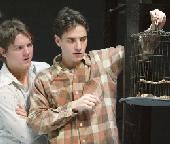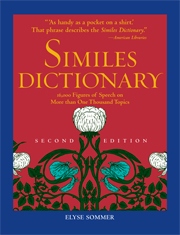Search Curtainup
SITE GUIDE
REVIEWS
REVIEW ARCHIVES
ADVERTISING AT CURTAINUP
FEATURES
NEWS
Broadway
Off-Broadway
NYC Restaurants
BOOKS and CDs
OTHER PLACES
Berkshires
London
California
New Jersey
DC
Philadelphia
Elsewhere
QUOTES
TKTS
PLAYWRIGHTS' ALBUMS
LETTERS TO EDITOR
FILM
LINKS
MISCELLANEOUS
Free Updates
Masthead
A CurtainUp Review
Birdy
By Elyse Sommer
|
We had a private club for two. From the time I was thirteen until I was seventeen I spent more time with Birdy than with everybody else put together. Sure, I chased girls and Birdy played with birds but he was actually the only person I was ever close to. --- Sergeant Al |

Zachary Knighton as Young Al & Peter Stadlen as Young Birdy
(Photo: Carol Rosegg ) |
It's easy to see why Wallace was attracted to William Wharton's hypnotic tale about an unlikely friendship between two teenagers -- one a macho body builder, the other an ethereal dreamer; both traumatized during their army service in World War II. Wallace's Heart of America dealt with the Gulf War . Trestle at Pope Lick Creek was about tragically confused teenagers who could have lived when we reviewed the play (in 1999) as during the depression days of 1937. The central characters in Birdy struggle to cope with the same sort of hellish realities.
With playwrights like Richard Greenberg and Jon Robin Baitz taking occasional breaks from their own plays to adapt other writers' work, it's also understandable why Wallace wanted to do the same thing. However, while Greenberg and Baitz stayed within the playwriting medium and stuck with established classics, Ms. Wallace's has upped the ante by tackling a popular but too young to achieve "classic" status work from a notoriously difficult to adapt genre.
Wallace's construct for moving Birdy from page to stage is artful and, with a strong assist from director Lisa Peterson, easy to follow. The jumps between the post war "present" and pre-war bonding of two boys with little in common other than their sense of being lonely outsiders are quite seamless. Using four actors to portray the trajectory of the friendship from boyhood bonding to post-war rescue mission creates a viable theatricality, with the flashback characters at times interacting with their post-war counterparts. Riccardo Hernández's spare two-tiered set supports the transitions from the post-war scenes in the mental hospital to the youthful adventures that revolve mostly around Young Birdy's obsession with birds and flight.
The play begins with 22-year-old Sergeant Al Columbato (Adam Rothenberg), still undergoing treatments for disfiguring wounds incurred during his tour of duty, called to the mental hospital where the resident psychiatrist, Doctor White (Richard Bekins), has been unable to break through the catatonic, non-eating state into which Al's friend Birdy (Ted Schneider) has retreated. The doctor hopes that Al, who seems made of tougher stuff than his friend, can somehow bring Birdy back to reality. Actually, Al's toughness and too frequently combative behavior is as much a way of coping with the harsh world as Birdy's crouching in a cage like one of the birds that were his boyhood passion and earned him his name. White is less well-intentioned caregiver than hostile, gung-ho army man. While Birdy's case is a challenge to him, he views men like him (and eventually, Al) as cowards and unfit to fight battle requiring real warriors.
Unlike the film which changed World War II to the Vietnam War, Ms. Wallace has adhered to the book's time frame which, given the pressures and often surreal situations faced by young American servicemen today, imbues the World War II background a timely timelessness. Her focus in depicting the increasingly close relationship between Al and Birdy is more a matter of their acceptance of each other's "specialness" than acting on any underlying homoerotic feelings -- Al's need to constantly toughen himself to withstand his father's cruel beatings and Birdy's other worldly passion for birds and his own attempts to experience flight (a metaphor for freedom). The homo-eroticism comes into play mostly through Dr. White's implications and, most strikingly, in a "present" scene in which Al finds a way to make Birdy eat by feeding him mouth-to-mouth. This bird-like "kiss" is poignant even though somewhat repugnant.
While no special effort has been made for the younger and older Al and Birdy to resemble each other, the audience is never at a loss to make the connection. However, what we are left with at the end of almost two hours isn't as compelling as it should be. The actors do very well by their characters. Adam Rothenberg stands out as the older Al. Peter Stadlen memorably portrays Birdy as an etherial but determined dreamer, fragile as a bird, but determined not to be trapped in the demands of his earthly life. Richard Bekins gives a chilling portrayal of Dr. White, a man one can picture locking horns with Randle P. McMurphy from One Flew Over the Cuckoo's Nest. The nurse in this play, ably portrayed by Teagle F. Bougere, is no Nurse Ratchet, however, but a savvy, conscientious objector who is beyond being surprised by any patient, even one who acts as if he were a bird. Perhaps the main characters would engage us more viscerally if Sergeant Al had a less skimpy bandage to evoke the extent of his facial disfigurement and if the older Birdy were less like any totally withdrawn mental patient and more, well bird-y and fluttery. To add to this failure to fully convey the dreamlike spirit that young Birdy embodies, his final scenes are unsurprising and almost jokey and matter-of fact. This robs the closing image of its potential magic.
While Birdy is, as Naomi Wallace hoped (per an interview in the program), a theater piece that works in its own right, it still suffers from the problems that tend to make adaptations like this somewhat less rather than more satisfying than reading the book.
LINKS TO REVIEWS OF OTHER PLAYS BY NAOMI WALLACE
One Flea Spare
The Trestle at Pope Lick Creek
| BIRDY
Adapted by Naomi Wallace, from William Wharton's novel Directed by Lisa Peterson Cast: Richard Bekins (Dr. White), Teagle F. Bougere (Renaldi), Zachary Knighton (Young Al), Adam Rothenberg (Sargeant Al Columbato), Ted Schneider (Birdy), Peter Stadlen (Young Birdy) Set Design: Riccardo Hernández Costume Design: Gabriel Berry Lighting Design: Scott Zielinski Sound Design: Jill BC Du Boff Original music: David Van Tieghem Running time: 1 hour and 50 minutes, includes one 10-minute intermission Women's Project and Productions at Women's Project Theatre, 424 West 55th Street 212-239-6200 11/22/03 to 12/21/03; opening 12/02/03. Tuesday through Saturday evenings at 8 p.m., and Saturdays and Sundays at 3 p.m. -- $45. Reviewed by Elyse Sommer based on November 27th press preview |

|


